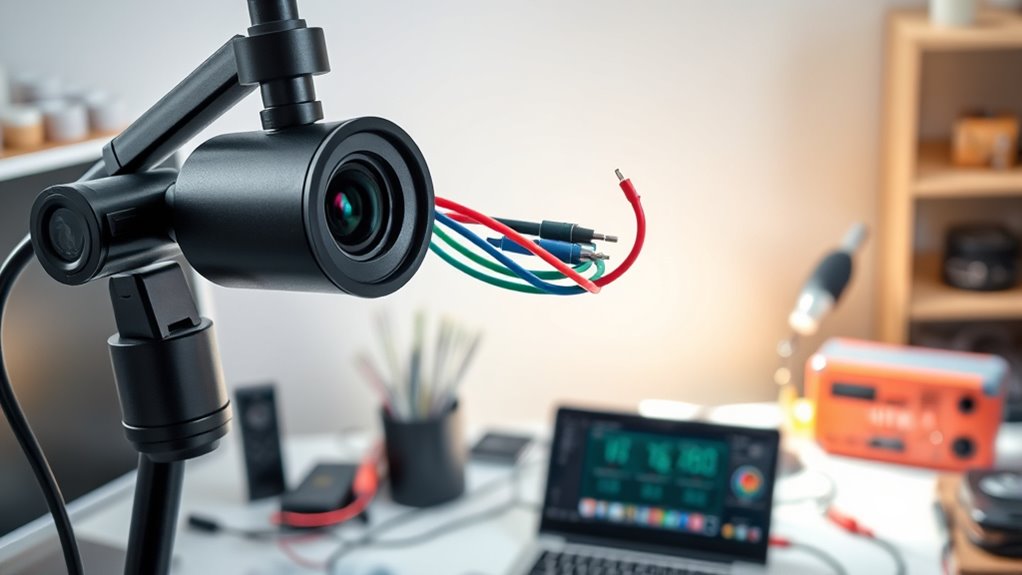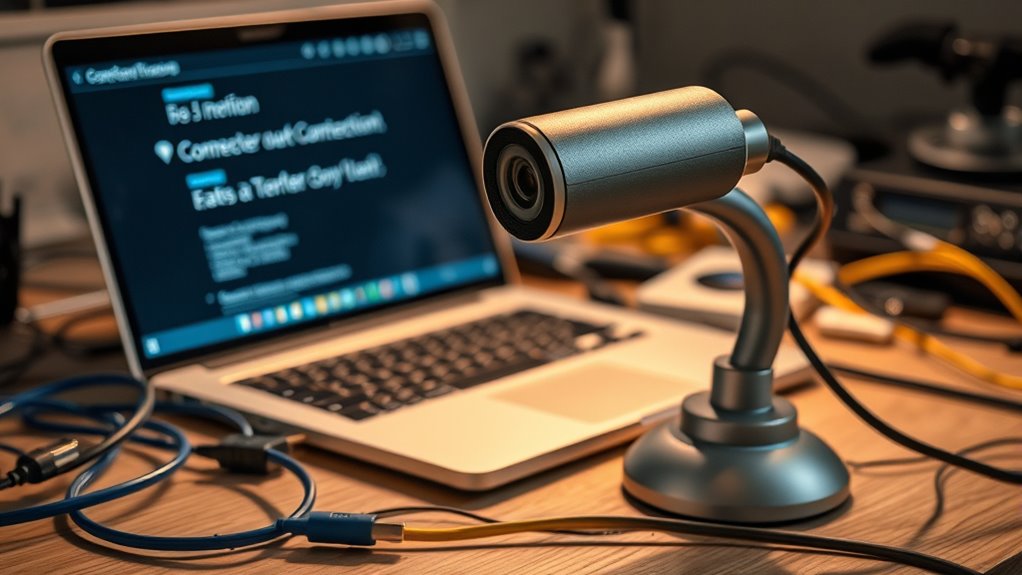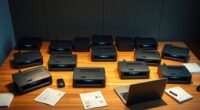To troubleshoot document camera connectivity issues, start by checking for Wi-Fi interference from other devices and confirm the camera is close to the router with a clear line of sight. Verify your network settings and update the camera’s firmware if needed. Make sure your power source is stable, and re-enter Wi-Fi credentials carefully. If problems persist, trying different outlets or reducing electronic interference can help. More tips ahead can guide you toward a smoother connection.
Key Takeaways
- Verify the camera is connected to the correct Wi-Fi network and that network credentials are accurate.
- Ensure the camera has a stable power supply and is plugged into a reliable outlet.
- Restart the router and camera to resolve temporary connectivity glitches.
- Reduce wireless interference by minimizing nearby electronic devices and switching to a 5 GHz network if available.
- Keep the camera firmware up to date and consult the manufacturer’s troubleshooting resources if issues persist.

Connecting a document camera can sometimes be tricky, but most issues are easy to resolve with a few simple steps. One common problem you might face involves connectivity disruptions caused by wireless interference or power supply issues. If your camera isn’t transmitting properly or keeps disconnecting, start by checking the wireless environment. Wireless interference from other devices like Wi-Fi routers, cordless phones, or Bluetooth gadgets can interfere with your camera’s signal. To improve connection stability, move your camera closer to the wireless router or access point, and reduce the number of competing devices operating on the same frequency. If your camera supports dual-band Wi-Fi, switching to a less congested 5 GHz network can considerably reduce interference.
Next, examine the power supply. A stable power source is vital for proper operation. Ensure that your camera is plugged into a reliable outlet and that the power cord isn’t damaged or loosely connected. If your device has a backup battery or an internal power source, verify that it’s charged and functioning correctly. Power interruptions can cause your camera to disconnect unexpectedly or fail to turn on altogether. Sometimes, using a different outlet or power strip can resolve power-related issues. Avoid overloading outlets, which can cause voltage fluctuations or power dips that affect your camera’s performance.
If you’re still experiencing connection issues, check your network settings. Confirm that your Wi-Fi network is active and that your device is connected to the correct network. Sometimes, a simple restart of your router and camera can clear temporary glitches. For wireless cameras, ensure that the firmware is up to date, as outdated software can cause compatibility issues or performance problems. Consult the camera’s manual for instructions on updating firmware, which often involves downloading the latest version from the manufacturer’s website. Additionally, understanding network reliability can help you troubleshoot persistent connectivity problems more effectively.
Another step is to verify the camera’s network credentials. Incorrect Wi-Fi passwords or security settings can prevent the camera from connecting properly. Re-enter the password carefully, making sure there are no typos. If your camera allows for network configuration via an app or web interface, double-check the settings to confirm everything aligns with your network parameters.
Frequently Asked Questions
Can a Document Camera Connect Wirelessly to a Computer?
Yes, a document camera can connect wirelessly to your computer. You’ll need a camera with built-in wireless capabilities that support a wireless connection. To get started, verify the camera is compatible with your computer and follow the manufacturer’s instructions for camera pairing. Most models will involve connecting to the same Wi-Fi network or using a dedicated app. Once paired successfully, you can easily display documents without cables.
What Should I Do if My Document Camera Isn’t Recognized by the Software?
Did you know that 68% of device recognition issues stem from outdated software? If your document camera isn’t recognized by the software, first verify your software is up to date. Then, check your user permissions—make sure you have admin rights if needed. Restart your computer and reconnect the camera. These steps often resolve recognition problems, enabling smooth operation and preventing future connectivity hiccups.
Is There a Way to Test if the Camera’s Port Is Faulty?
To test if the camera’s port is faulty, you should perform port testing by connecting the camera to a different port on your device. If it works on another port, the original port may be faulty. For faulty port diagnosis, try plugging other devices into the same port to see if they work. If they don’t, you likely have a faulty port, and you might need to repair or replace it.
How Do I Troubleshoot Audio Issues With My Document Camera?
Of course, troubleshooting audio issues with your document camera is as simple as expecting it to work flawlessly every time. Start by checking the connection stability—ensure all cables are plugged in securely. Then, test the audio with different devices or apps to pinpoint the problem. Adjust volume settings on both your camera and computer. If issues persist, update drivers or try reinstalling the software. Easy, right?
What Compatibility Issues Might Prevent My Document Camera From Connecting?
When your document camera won’t connect, check for compatibility issues. Software conflicts can prevent proper communication between your device and the computer, so verify your camera’s software is up to date and compatible with your operating system. Also, confirm the power supply is stable; a weak or inconsistent power source might cause connection problems. Address these issues, and you’ll improve your chances of establishing a successful connection.
Conclusion
By checking your connections, updating your drivers, and restarting your devices, you can resolve most document camera issues. When you troubleshoot step by step, you gain confidence, save time, and prevent frustration. When you stay patient, stay persistent, and stay proactive, you’ll keep your lessons running smoothly. Remember, troubleshooting isn’t just about fixing problems; it’s about empowering yourself to keep teaching seamlessly, no matter what tech challenges come your way.









